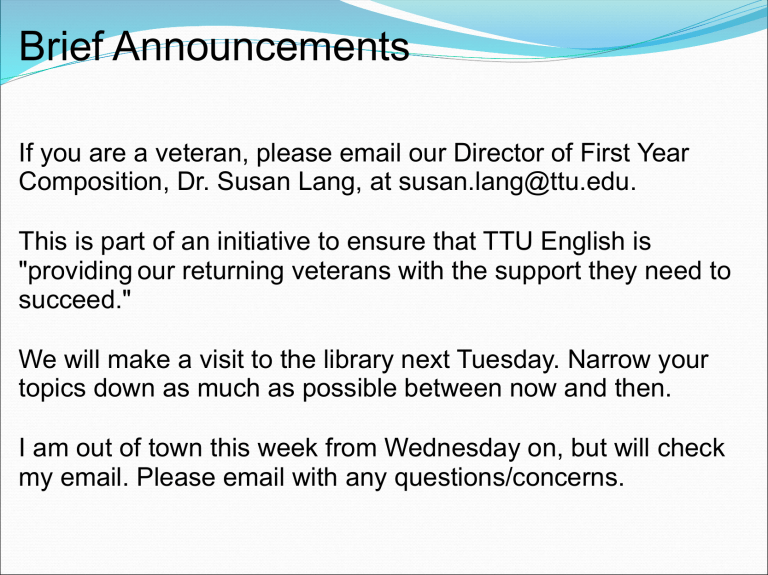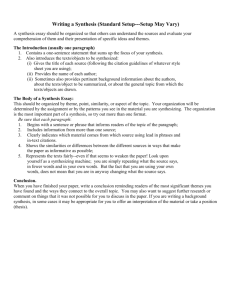PowerPoint - WordPress.com

Brief Announcements
If you are a veteran, please email our Director of First Year
Composition, Dr. Susan Lang, at susan.lang@ttu.edu.
This is part of an initiative to ensure that TTU English is
"providing our returning veterans with the support they need to succeed."
We will make a visit to the library next Tuesday. Narrow your topics down as much as possible between now and then.
I am out of town this week from Wednesday on, but will check my email. Please email with any questions/concerns.
•
•
•
•
•
What does “synthesize” mean?
To combine two or more summaries in a meaningful way
To identify common theme or idea that runs through several sources
(articles)
To discuss how each article develops/contributes to a theme
To draw together particular themes or traits that you observe in chosen texts
To organize the material from each text according to those themes or traits
•
•
•
Key aspects to synthesizing
It accurately reports information from the sources using different phrases and sentences
It is organized in such a way that readers can immediately see where the information from the sources overlap;.
It makes sense of the sources and helps the reader understand them in greater depth.
In what ways can we synthesize info?
•
• synthesis essay should be organized so that others can understand the sources and evaluate your comprehension of them and their presentation of specific data, themes, etc.
Can provide textual analysis, graphs, charts
For the purposes of this class, however, ONLY TEXT
Intro (suggestion)
1.
A.
Contains a one-sentence statement that sums up the focus of your synthesis.
i.
ii.
iii.
Also introduces the texts to be synthesized:
Gives the title of each source (following MLA format);
Provides the name of each author;
Sometimes also provides pertinent background information about the authors, about the texts to be summarized, or about the general topic from which the texts are drawn.
Body (suggestion)
Be sure that each paragraph:
1.
2.
3.
Begins with a sentence or phrase that informs readers of the topic of the paragraph;
Includes information from more than one source;
Clearly indicates which material comes from which source using lead in phrases and in-text citations. [Beware of plagiarism: Accidental plagiarism most often occurs when students are synthesizing sources and do not indicate where the synthesis ends and their own comments begin or vice verse.]
Body pt. II
1.
2.
Shows the similarities or differences between the different sources in ways that make the paper as informative as possible;
Represents the texts fairly--even if that seems to weaken the paper! Look upon yourself as a synthesizing machine; you are simply repeating what the source says, in fewer words and in your own words. But the fact that you are using your own words does not mean that you are in any way changing what the source says.
Conclusion (suggestion)
•
• Remind the readers of the most significant themes you have found and the ways they connect to the overall topic
May also:
suggest further research comment on things that it was not possible for you to discuss in the paper
Adapted from http://users.drew.edu/~sjamieso/synthesis.htm
Venn Diagrams
Helpful way to find similarities across topics.
http://nymag.com/daily/entertainment/2012/01/reailt y-show-venn-diagram.html
Evaluation rubric for your synthesis
C1 —Issue Identification and Focus
Does the student focus on a common theme or idea that runs through each article?
C2 —Context and Assumptions
Does the student show an awareness of the context in which the source was written?
C3 —Sources and Evidence
Does the student thoroughly explore the relationship/connection between the articles? Does the student use MLA format correctly?
C5 —Own Perspective
Is the student’s own voice apparent or does the student just summarize the viewpoints of the authors?
C6 —Conclusion
Does the conclusion effectively pull the analysis together?
C7 —Communication
Is the essay organized effectively?
How effective is the student’s writing at the sentence level?
End Product for today
1. A solid paragraph sample synthesis that covers the basics of synthesis discussed in the ppt.
2. Your synthesis should draw on the various reviews but leave out your own opinion.
3. The sample synthesis will be shared with the class before we dismiss.
4. Please take notes on the samples as they are read, as we will discuss effective choices for writing a solid synthesis.
Search Tips for Your Topic
• Reading/Annotating Articles
• Finding keywords can help you identify trends or patterns in the research. (Should have a total of 3-5 total for the most efficient searches) o o
Don't use the topic as a keyword always. If you're writing about global warming and have an article on the polar ice caps avoid using "global warming" as a keyword.
Use consistent keywords--that is, to use "obesity" every time instead of "obesity" once and then "overweight," "corpulence," etc. for the others.
Keyword Chart
Authors in one column the article in another, and a keyword in the third.
Then sort the column by keyword. This way, you can find trends in the research more quickly and can narrow their topics.
You will need to choose topics that are closely related to each other.





